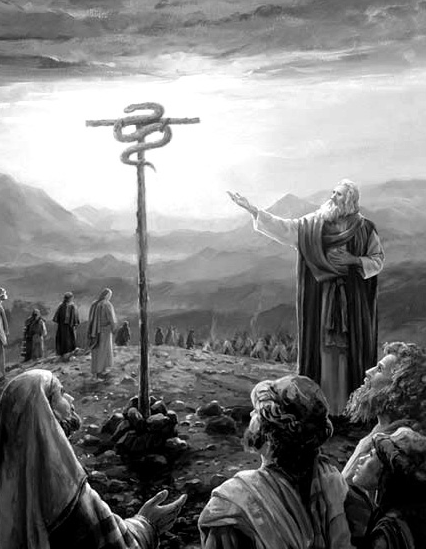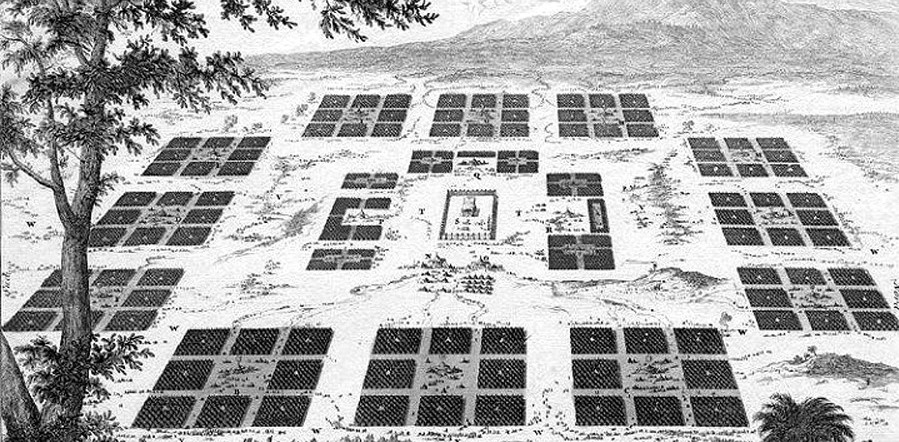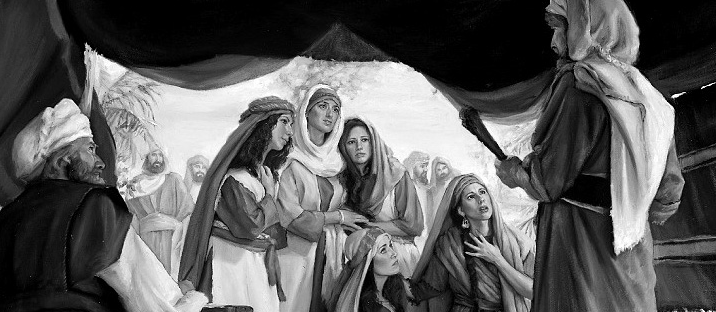Numbers
“Jehovah spake unto Moses in the wilderness of Sinai, in the tabernacle of the congregation, on the first day of the second month, in the second year after they were come out of the land of Egypt” (Numbers 1:1).
What Christians refer to as the Old Testament, Jewish believers refer to as the Tanakh — a word assembled from the letters TNK, signifying the Torah (law), Neviim (prophets), and Kethuvim (writings). The of Numbers in the Hebrew Tanakh “In the Wilderness” or desert.
We refer to it as “Numbers” because it opens with a census of Israelites, setting the stage for the wilderness wanderings. In symbol, this sets the stage for the opening of the Gospel Age sojourn of the Church through the “wilderness” of their trial and testing as disciples of Christ. Another census comes later in Numbers, representing a “reset” of the Christian effort at the Reformation.
If we look at the symbolism of the experiences of Israel in this book, there are four main divisions. These mostly cover the Gospel Age, but also take us into the Kingdom. The four divisions are:
(1) Chapters 1‑9. The first five chapters give an overview of the Gospel Age, the next four picture four classes of faith: the Church, Ancient Worthies, Great Company, and the World in the Kingdom.
(2) Chapters 10‑21. Chapters 10-17 of this section give us seven narratives outlining the seven stages of the Church through the Gospel Age. The next four chapters pertain to the same four classes as above: the Church, Ancient Worthies, Great Company, and the World.
(3) Chapters 22‑27 — another pass through the seven stages of the Gospel Age, leading toward the Kingdom with the appointment of Joshua (Christ) in Numbers 27:18.
(4) Chapters 28‑36 — nine chapters referring to the transition between the Gospel Age and the Millennial Age.
SECTION ONE — CHAPTERS 1‑9
Exodus 40 begins a picture of the Gospel Age with a new year. Numbers begins a similar picture with the beginning of a new month. In the first case it is year two, in the second case month two, an appropriate number as it represents the holy Spirit which comes to us through the two olive trees, two parts of holy writ, the Old and New Testaments (Revelation 11:3, Zechariah 4:3, 14).
In the opening chapters there is a distinction between the Israelites and the Levites. The Levites, in chapter three, are a special tribe for godly service, exchanged for the Firstborn. At the Passover supper in Egypt, the Firstborn represented the Church class during the Gospel Age (Hebrews 12:23). The other Israelites feasting on the pass over lamb that night represented believers in Jesus. They all had come through the door displaying the blood of the lamb. The unbelieving Egyptians outside represented the world of mankind. So here in the Book of Numbers — the Israelites are Christian believers, the Levites are consecrated saints.
 On Jesus were laid our sins.
On Jesus were laid our sins.
Chapter two describes the camp of the Israelites. They are arranged as three tribes each on the east, south, west, and north of the tabernacle. Each group of three was led by a firstborn of a sort. Judah had the favored position on the east. He was actually the fourth born of Leah, but because of deficiencies in Reuben, Simeon, and Levi, Judah became a leader among the tribes (1 Chronicles 5:2). His group of three included Issachar and Zebulun, sons of Leah following Judah.
had the favored position on the east. He was actually the fourth born of Leah, but because of deficiencies in Reuben, Simeon, and Levi, Judah became a leader among the tribes (1 Chronicles 5:2). His group of three included Issachar and Zebulun, sons of Leah following Judah.
To the south Reuben, the natural firstborn of Leah, was leader of Simeon, the second born of Leah, and Gad. Levi might be expected here, as the next born of Leah, but the Levites will be separately arranged around the Tabernacle, so Gad appears here instead. Gad was the firstborn of Leah’s handmaid, Zilpah.
On the East side were the children of Rachel, Ephraim and Manasseh, both of Joseph, then Benjamin, Rachel=s second born. This group is headed by Ephraim, whom Jacob had blessed above his older brother Manasseh.
On the north are the remaining children of the handmaids — Dan, Asher, and Naphtali. Dan was the firstborn of Rachel=s handmaid, Bilhah, Asher was the second born of Leah=s handmaid, and Naphtali was the second born of Rachel=s handmaid, presumably born after Asher.
Around the Tabernacle, between it and the camp of the outer 12 tribes, were four camps of Levites. Moses, Aaron, and their families were on the favored east side. The other families of their clan, Kohath, were on the south, Merari on the north, and Gershon on the west.
In Volume 6, page 128, Br. Russell suggests that these four camps of Levites represent four classes of devoted ones that ultimately spring from the Divine Plan. The families of Moses and Aaron on the east represent the Church. Kohath, “ally,” represents the Ancient Worthies, Old Testament companions to the Church. Merari, “bitter,” suggests the cleansing experiences of the Great Company. Gershon, “refugee,” fits mankind in the Kingdom.
We had some reserve about this application, thinking of the wilderness experiences as primarily a Gospel Age picture. However, the suggestions are strengthened when we see that in chapters 6, 7, 8, 9 we have the same four classes again — and yet again in chapters 18, 19, 20, 21.
Other than this glimpse into the final results of the Divine Plan, chapters 1 to 4 set the scene for the wanderings of the Israelites, a picture of Christians — believers and consecrated — ready to travel through the Gospel Age. Chapter five then adds a test of fidelity that applies to the saints during this age. Will we prove faithful to our betrothed, Jesus?
In this case a woman suspected of infidelity was tested. Some of the dust of the holy was mixed with water, and the woman was to drink of this mixture. If she was pure, there would be no harm — but if she was impure, she would lose the fruit of her unfaithfulness (Numbers 5:27, NIV). The Church, spiritually, dwells in the holy. We are justified, but we still are in contact with the “dust” of the floor, the things of this world. This may be mixed with the water of truth in our experiences here. If we are faithful to Christ, the mixture will not harm us. But if we are wayward in our affections, we will suffer loss.
Chapter 6 is about the vow of the Nazirite, representing the Church class. Chapter 7 introduces the princes of Israel who step forward with a commitment on behalf of Israel to commit them to the service of God. We think this represents the Ancient Worthies, who after the Gospel Age, step forward to lead Israel in commitment to God.
In Chapter 8 the Levites are distinguished from the priests. The Levites wash their robes and are given to the Priests as a helper class, representing the Great Company class who wash their robes in the closing experiences of this age before assisting the Church in glory.
Chapter 9 raises the question about those who were unclean, or away on a journey, and so missed the Passover, in the first month of year two. The answer is that they must keep the Passover in month two, at full moon. This represents mankind who are unclean, or away from God, during the Gospel Age. If they are to have life, they must eat the passover lamb, in this case at the second opportunity, at the next time Israel’s favor is full, during the Kingdom. So, chapter nine is about the World of mankind.
SECTION TWO — CHAPTERS 10‑21
Chapters 10‑17 give seven narratives, each pertaining to one of the seven stages of the Gospel Age. Chapter 10 introduces two silver trumpets, representing the two parts of the Bible, the Old and New Testaments, the second one now provided by the Gospels and Epistles of the Apostles. Chapter 11 speaks of murmuring, stimulated by the “mix multitude” (Numbers 11:4), reminding us of the tare class becoming notable in the second stage of the Church (Matthew 13:25, Revelation 2:9). Chapter 12 speaks of a leadership challenge, as the leaders of Christendom in the Pergamos phase turned toward worldly, political goals. In chapters 13 and 14 the Israelites refused to enter the promised land, afraid of the struggle, as in the dark days of the Thyatira period, many gave up on spiritual things, misled by Jezebel=s influence (Revelation 2:20).
 Camp of the Israelites
Camp of the Israelites
Chapter 15 speaks of a man picking up sticks on the Sabbath day, reminding us spiritually of those who turn away from the cross to imitation sources, “sticks,” rather than resting by faith in the finished work of Christ (Hebrews 4:11). These “sticks” may represent penances, indulgences, and rituals, promoted by Papacy, rather than trusting in the redemption Christ provided at Calvary. Martin Luther and other reformers stepped out boldly in the 1500s, affirming that faith in Christ’s sacrifice was the only sure foundation for our heavenly hopes.
Chapter 16 speaks of a rebellion overturned by an earthquake, reminding us of the earthquake of the French Revolution, in church period number six. It was a strong judgment against rebellious Papacy. In Chapter 17 Aaron’s rod that budded showed God’s true choice of the sacred priesthood. This seems fulfilled in the budding of the saints beyond the vail, in the first resurrection, during the seventh phase of the Church.
Chapters 18‑21 then refer to the same four classes as in chapters 6‑9. Chapter 18 is about the duties of the priests, representing the Church in the Kingdom. Chapter 19 is about the Red Heifer, which Tabernacle Shadows applies to the Ancient Worthies. The ashes, or residual experiences, of the Ancient Worthies, applied to the world in the Kingdom, help cleanse them from the residual effects of sin. In chapter 20 Moses smites the rock to issue the water of life, the second occasion of this kind, representing when Jesus, the rock of our salvation, will issue forth the river of life in the Kingdom. The chapter closes with the death of Aaron at Mount Hor, representing the end of the service of Jesus as high priest of the Gospel Age. The close of that ministry is marked by the completion of the Great Company class. In chapter 21 the copper serpent on a pole heals all who look to it — the rescue of the world in the Kingdom. (John 3:14).
OTHER DETAILS
Our summary of these chapters is brief, sometimes only a mention of lessons contained. Many details merit fuller explanation. We pause here to give one suggestion from Numbers chapter 21. We think that the opening verses of this chapter refer to Israel as they approach the kingdom, during the present Harvest time, before they acclaim Christ as their Savior.
In Numbers 21:1, in the last year of their wilderness experience, Israel suffered a blow from the king of Arad. He fought Israel and took many prisoners. Prison elsewhere is symbolic of the prison house of death (Revelation 2:10, Isaiah 42:7). We think that this experience represents the holocaust that Israel experienced. As a result, Arad was turned into “Hormah,” desolation. After the holocaust, Germany was turned to ruin by carpet bombing from the west and Russian forces from the east, and the country was split, before it gradually recovered.
More years would follow, and Israel, though blessed with statehood again, would have cause for more difficulties. In Numbers 21:4-6 the Israelites were discouraged, complained, and suffered bites of venomous serpents, until recognizing deliverance by the serpent on the pole, symbolizing Israel=s yet future appreciation of Jesus.
SECTION THREE — CHAPTERS 22‑27
Next follows another sequence taking us through seven parts of the Gospel Age. Chapter 22 introduces Balaam, who tried to bring a curse on the Israelites. Revelation 2:14 refers to this episode, connecting it to the Pergamos church. Balak, the leader of this effort, perhaps represents Satan in his effort to curse the people of God.
Balak, of Moab, endeavored to bribe Balaam to curse Israel. At first Balaam stood firm and rejected the inducement of worldly goods — as leaders in the early church stood pure and even suffered for their faith. In the second part of Numbers 22, Balaam weakened — as some did also in the second stage of the Church. In chapters 23 and 24, Balaam yielded to the appeal of Mammon and assisted Balak — as some church leaders in the Pergamos phase cooperated with earthly rulers for earthly gain. In chapter 25 the Israelites succumbed to whoredom with women from Moab, induced by Balaam (Numbers 31:8,16) — as during Thyatira, many lost their spiritual lives for spiritual fornication (Revelation 2:22, 23).
In Numbers 26 there is a new census, suggesting a new beginning of the work of the Gospel Age from the Reformation forward. In Chapter 27 five virgins, daughters of Zelophehad, inquire about their inheritance. In the sixth period of the church, before the return of Christ, the saints are depicted as five wise virgins waiting for the Lord in the parable of the wise and foolish virgins. In Numbers 27:18 a new leader is appointed. Joshua here pictures Jesus, appointed to lead people into and through the Kingdom. This may picture Jesus leading us through the transition period of church seven, and across the Jordan into the Kingdom.
SECTION FOUR — CHAPTERS 28‑36
These nine chapters symbolically cover a transition of the ages, from the Gospel Age into the Millennial Age. Chapters 28 and 29 review the holy days of Israel, which pertain to both ages. Chapter 30 speaks of vows of a woman that need to be affirmed either by one’s husband or one’s father, or they may be cancelled. Here the woman represents all of us who make commitments for our faith. In the Christian world, those who are not full-hearted about their commitments will not be recognized by Christ.
 Five daughters of Zelophehad (representing the Church)
Five daughters of Zelophehad (representing the Church)
“Many will say to me in that day, Lord, Lord … then will I profess unto them, I never knew you” (Matthew 7:22, 23). If vows and commitments are not recognized by our heavenly bridegroom, Jesus, or our Father, Jehovah, then they may be set aside. Apparently this will pertain to many in the Christian world who have not been true. This will become apparent at the change of ages, for many who considered themselves headed for above will instead find themselves here, on earth.
Chapter 31 speaks of a battle against Midian, perhaps representing the final turmoils bringing us into the Kingdom, from Armageddon forward. In chapter 32 two tribes, and part of another, receive their inheritance on the east side of the Jordan river before Israel crossed the Jordan into Canaan. This has long been seen as the Church (Reuben, the firstborn class), the Great Company (Gad, a troop), and the Ancient Worthies (Manasseh, half on either side of the Jordan). Thus two spiritual classes receive their reward before mankind in the Kingdom, and the Ancient Worthies are depicted as a class connecting the heavenly phase of the Kingdom with the earthly phase.
Chapters 33 and 34 give us a retrospective and prospective view. Chapter 33 reviews the history of 40 years in the wilderness, a gaze back upon the completed Gospel Age. Chapter 34 gives the borders of the land of promise that the Israelites were ready to conquer, a look forward to the opportunity for mankind in the Kingdom.
Chapter 35 speaks of the Cities of Refuge, three on each side of the Jordan, showing how the saints in the Gospel Age presently, and the world in the Kingdom future, have refuge in Christ. The cities of refuge are for people unintentionally guilty of a capital crime. This pertains to all of Adam’s race, for we are all worthy of the penalty sin brings, but it has been an unintentional connection with sin, inherited from our forefathers. Those who flee to a city of refuge must remain there until the death of the then current high priest — showing that we now, and the world in the Kingdom, need to abide in Christ until our high priest completes his work for either respective age in which we are involved.
Chapter 36 gives regulations to assure that one=s family heritage is secure. This probably represents that the heritage of all the redeemed — the Church presently, and the world in the Kingdom — will be secure and sealed as an everlasting inheritance.
— Br. David Rice
